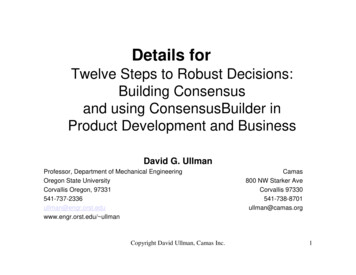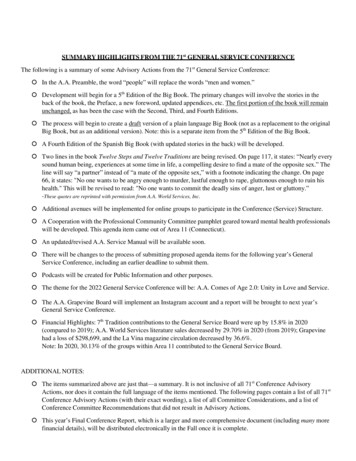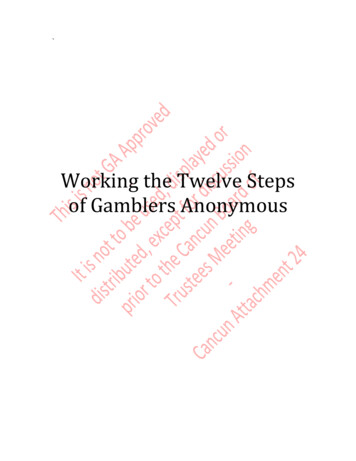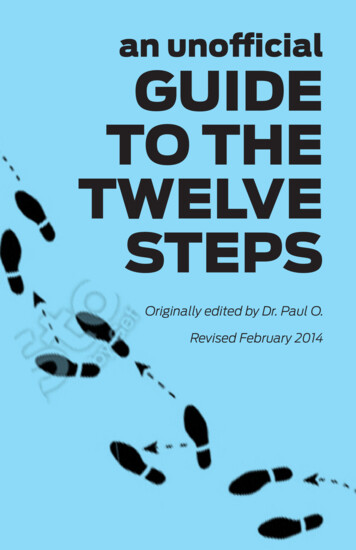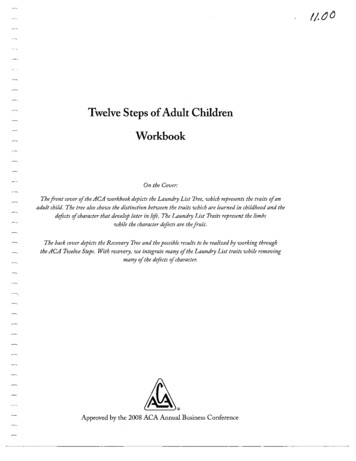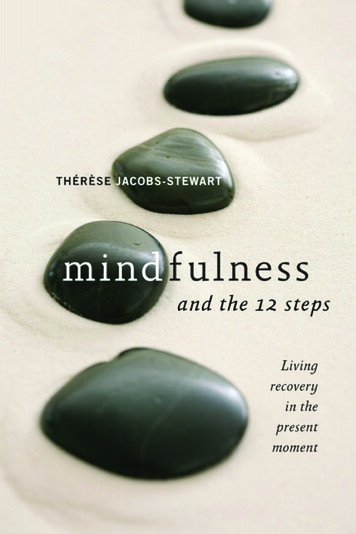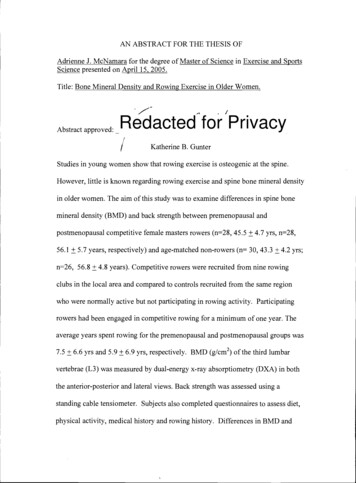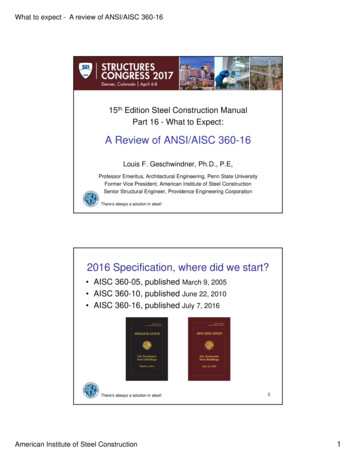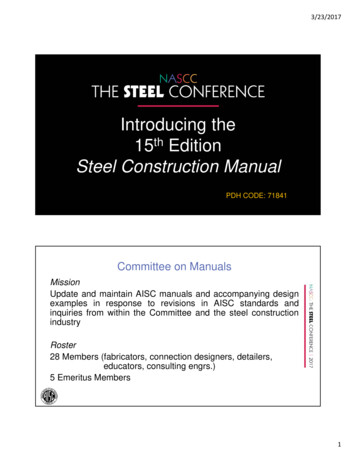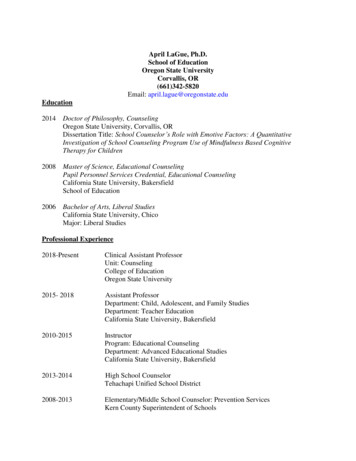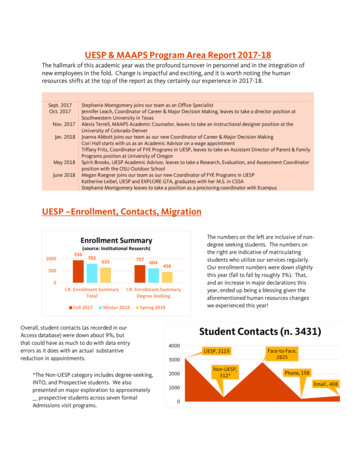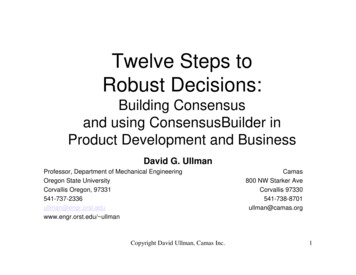
Transcription
Twelve Steps toRobust Decisions:Building Consensusand using ConsensusBuilder inProduct Development and BusinessDavid G. UllmanProfessor, Department of Mechanical EngineeringOregon State UniversityCorvallis Oregon, .edu/ ullmanCopyright David Ullman, Camas Inc.Camas800 NW Starker AveCorvallis 97330541-738-8701ullman@camas.org1
Who I am Professor Mechanical Engineering Design, 20 years Fellow, American Society of Mechanical Engineers Professional designer: founder and chiefdesigner for BikeE Corp (www.bikee.com)Copyright David Ullman, Camas Inc.2
Who I am Design methods researcher Author of The Mechanical Design Process Founder of the ASME Design Theory andMethodology Committee Short Course Teacher: Modern Design Methods,Taguchi’s Method of Robust Design, 10 Steps toRobust Decision-Making. Principal in Camas and developer of iDecisionCopyright David Ullman, Camas Inc.3
An example of a typical problem faced inbusiness, industry or our personal livesMy friends Bob and Carol, and I want to go to a restaurant fordinner. Our conversation is as follows: Bob: I wouldn’t mind Mexican, I know a place that’s cheap.Carol: Is the food any good?Bob: I don’t really know. I haven’t been there in years.ME: I’m not in the mood for Mexican. I know a Thai place thathas great food. Bob: You mean the place on 2nd. Me: Yeah!Copyright David Ullman, Camas Inc.4
Bob: I ate there a couple of weeks ago and didn’t like it at all.Also I can’t afford that place. Carol: How was the service? Bob: It was ok. Me (at the same time): It was slow. But, do we care? Wearen’t in a hurry. Bob: We aren’t getting anywhere very fast and I am hungry.What about the steak place around the corner? Me: At least its close! Carol: I became a vegetarian last week. No steak places forme. Bob: I am sure it has a veggie menu also. I can call and doublecheck on this. and so on until hunger or fatigue forces a choice .Copyright David Ullman, Camas Inc.5
3 truths about decision-making The solution of most problems is the evolutionof information punctuated by decisions For the vast majority of problems, there are noright answers, only satisfactory answers. A decision is a commitment to use resources.
Four key questions, asked eitherconsciously or unconsciously, every timea decision is made:1. What is the best alternative?2. Do we know enough to make a gooddecision yet?3. What do we need to do next to feelconfident about our decision?4. Is there team consensus about thedecision?Copyright David Ullman, Camas Inc.7
Value of viorValueModelsRelationshipsDataCopyright David Ullman, Camas Inc.8
Design Problem Solving ResearchResults Planning is about 75% deductionIf situation then do this activity . Design work is only 13 % deduction Design is mainly search– Develop criteria– Generate alternatives– Compare alternatives to criteria– Decide what to do nextCopyright David Ullman, Camas Inc.9
Decision-making flowClarify eAlternativesUsing CriteriaDecide whatto do nextDocumentDecisionGenerate New IssuesCopyright David Ullman, Camas Inc.10
Robust Decision-Making ModelIssueNOISESCriteria Description of asatisfactory solutionEvaluateAlternatives andDecideA selectedalternativeAlternativesCopyright David Ullman, Camas Inc.11
Noise any factor that you cannot orchoose not to control. Poor personal problem solving style Conflicting interaction of problem solving styles on a team Weak understanding of the issue Poorly developed team shared understanding Team disagreement about what is important Considering too few alternatives Insufficient evaluation of alternatives Following a poor decision-making strategy Limited resources of time, people or equipment.Copyright David Ullman, Camas Inc.12
Robust decision-making means followinga strategy that eliminates all possiblenoises within the resources available,then making a decision that is asinsensitive as possible to the remainingnoise conditions.Such a decision is the best possible andleast likely to need changing later.Copyright David Ullman, Camas Inc.13
12 Steps to Robust DecisionsStep 1. Maximize personal decision-making effectiveness.Step 2. Insure team and organization effectiveness.Step 3. State the issue.Step 4. Identify the customers.Step 5. Itemize solution features.Step 6. Define targets for the features.Step 7. Measure feature importance.Step 8. Generate alternative solutions.Step 9. Measure decision-makers’knowledge.Step 10. Determine belief in alternatives’ability to meet targets.Step 11. Determine overall satisfaction in alternatives.Step 12. Decide what to do next.Copyright David Ullman, Camas Inc.14
Benefits of using the methods Encourage sound decision-making skills.Organize decision-making to be most effective.Support robust decisions.Analytically support decision-making.Develop a strategy to resolve issues.Rationally decide what to do nextCommunicate what is important.Develop a common understanding.Enable effective meetings.Develop documentation of the decision.Support information review and reuse.Reduce “fire fighting.”Copyright David Ullman, Camas Inc.15
Introduction toConsensusBuilder/iDecisionCopyright David Ullman, Camas Inc.16
Genesis of ConsensusBuilder/iDecision IPS (Information processing system, Herb Simon, 1972) Protocol studies of mechanical designers (Stauffer, 198588) IBIS (Issues, alternatives, and options, Conklin, 1980s) IBIS/DT (Decision theoretic extension of IBIS, 1995) Theory-W (Boehm, requirements negotiation, 1995) ConsensusBuilder (stand alone, 1998) iDecision (marketed by NexPrise, Summer 1999) Ten Steps for Robust Decision-Making, (2000)Copyright David Ullman, Camas Inc.17
A issueGFHGBDCECopyright David Ullman, Camas Inc.18
Example with Alternatives A1 and A2 and Criteria C1 and C2Copyright David Ullman, Camas Inc.19
Very high knowledge and confidence for A1 meeting C1 and C2I am an expert andI am sure that thealternative fullymeets the target setby the criteriaCopyright David Ullman, Camas Inc.20
Neutral confidence for A1 meeting C1 and C2I am an expertand I am notsure whether itmeets the targetor notCopyright David Ullman, Camas Inc.21
Low knowledge resultsI am aFlamingoptimistI am Eeyorefrom Winnie thePoohCopyright David Ullman, Camas Inc.22
Evaluation for A1 with even weightings for C1 and C2Copyright David Ullman, Camas Inc.23
Evaluation for A1 with weightings skewed toward C2Copyright David Ullman, Camas Inc.24
Example with Alternatives A1 and A2 and criteria C1 and C2Copyright David Ullman, Camas Inc.25
With 2 decision makersCopyright David Ullman, Camas Inc.26
From M1’s viewpointCopyright David Ullman, Camas Inc.27
From M2’s viewpointCopyright David Ullman, Camas Inc.28
Strategy for what to do next 1/2If, regardless of viewpoint, moreevaluation will not change whichalternative is chosen,Reach agreement and documentthe selection of the alternativewith highest satisfactionIf confidence in an alternative’sability to meet a criterion variesgreatly,Further interpret and discussevaluation information. Refinealternatives, criteria and belief mapsIf knowledge about a highlyweighted characteristic of analternative is low,Develop more evaluation informationusing experiments, analysis, or experts.Copyright David Ullman, Camas Inc.29
Strategy for what to do next 2/2If a criterion is weak, and is importantfrom at least one viewpoint, or isprominent in the expert knowledgeevaluation,If confidence in all alternatives is low.If previous items do not bringconsensus,If an alternative or criterion leads to a newissue.Refine characteristics and target forcriterion.Generate new alternative solutionsNegotiate changes in criteriacharacteristics, targets and importance.Decompose the issue into sub-issuesCopyright David Ullman, Camas Inc.30
12 Steps to Robust DecisionsStep 1. Maximize personal decision-making effectiveness.Step 2. Insure team and organization effectiveness.Step 3. State the issue.Step 4. Identify the customers.Step 5. Itemize solution features.Step 6. Define targets for the features.Step 7. Measure feature importance.Step 8. Generate alternative solutions.Step 9. Measure decision-makers’knowledge.Step 10. Determine belief in alternatives’ability to meet targets.Step 11. Determine overall satisfaction in alternatives.Step 12. Decide what to do next.Copyright David Ullman, Camas Inc.31
End of Introduction
12 Steps to Robust Decisions Step 1. Maximize personal decision-making effectiveness. Step 2. Insure team and organization effectiveness. Step 3. State the issue. Step 4. Identify thecustomers. Step 5. Itemize solution features. Step 6. Define targets for the features. Step 7. Measure feature importance. St
